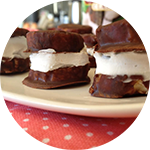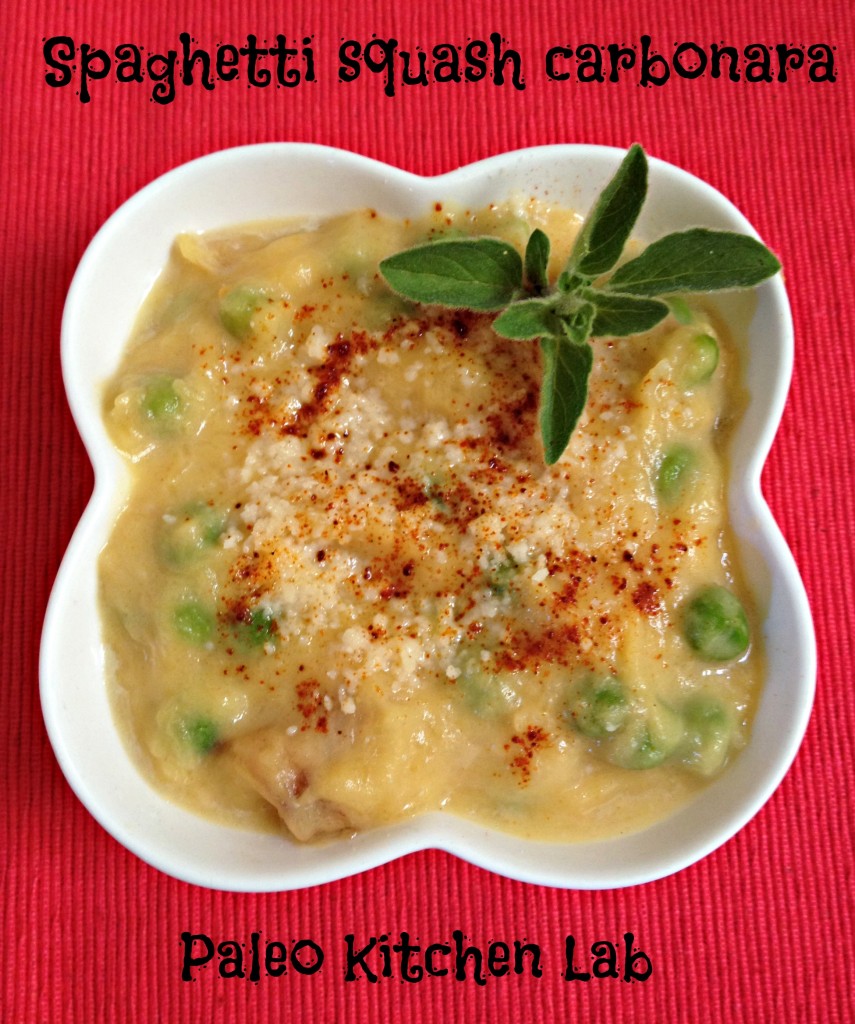Spaghetti squash carbonara
I love kitchen mistakes. They lead to amazing culinary discoveries.
Most people are afraid of screwing up in the kitchen, but it’s my intrepid attitude that makes cooking so fun. Having an experimental approach makes me less attached to results.
I trust, that at the worst, it will be edible. And at best, I’ll learn something useful and make a delicious mistake.
This recipe started out with a screw up but turned out divine.
I decided to make spaghetti squash carbonara but overcooked the squash. I meant to put it in the oven at 350 for 1 hour. But I left it there closer to 2 hours. Oops.
Instead of its usual spaghetti-like consistency, it became a caramelized squash pudding.
Pasta dishes are all about the sauce anyway, and a concoction of cheese, cream, butter, bacon and crisp green peas can save anything.
Mixing the squash and sauce produced a creamy, polenta-like creation. It was so comforting and creamy. Like a thick, cheesy soup.
My husband asked if the dish was healthy. I put on my health coaching hat and told him it was fine in moderation, and only if dairy is tolerated. I use the organic stuff, and raw dairy when available.
Dairy is a controversial food in the health community. Some experts love it and some hate it.
Last month I did a 30 day dairy cleanse to see if I was sensitive to the stuff. I didn’t feel any different off of it. And eating it again after 30 days gave me no reaction. That’s how I know I can handle it.
And lately I’ve been making up for all the dairy I missed out on.
If I HAD to give up dairy for health reasons, I would, but I’m so happy I can enjoy decadence like this, occasionally. It makes me happy. And isn’t happiness good for your health?
Ingredients
1/2 cup of peas (ok to use frozen straight from the bag)
Onion (one quarter, chopped)
3 slices of bacon
1/2 cup of cream
butter or olive oil
1/4 cup of Parmesan cheese
2 garlic cloves, chopped
salt to taste
paprika for garnish
1 roasted spaghetti squash
(optional for spice heads like me: 1/4 jalapeno pepper, chopped)
How to
Roast a spaghetti squash in the oven at 350. I usually roast mine for 1 hour then test it by sticking a knife it in to see if it’s done. It is done when the knife slides through easily.
Sautee the onions in olive oil or butter (or fat of choice) until they start to turn translucent. Add in chopped garlic and cook for a few minutes. If you like spice, add chopped jalapeno to taste.
Throw in bacon, chopped into small pieces, and cook for a few minutes.
Pour in heavy whipping cream (can also use half and half in a pinch) and let cook for 5 minutes while stirring.
Add in cheese and stir.
Add salt and peas (ok if they’re still frozen) and let simmer on low heat uncovered for 10 minutes to let the sauce reduce.
Take spaghetti squash out of the oven, let it cool down. Cut it in half. Scoop out and throw away seeds. With a fork remove the flesh and put it in a bowl. Mix in the sauce and stir.
Garnish with a sprinkle of smoked or regular paprika.
Serve to dairy-loving peeps for instant happiness.



